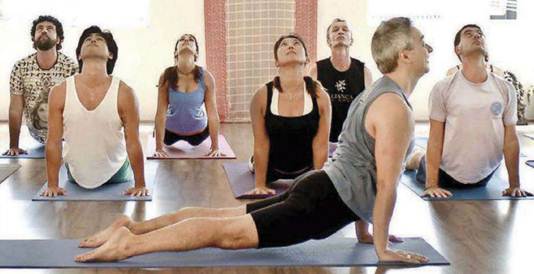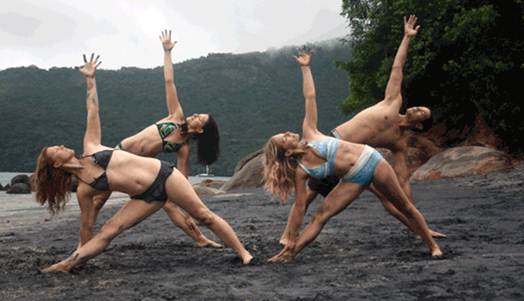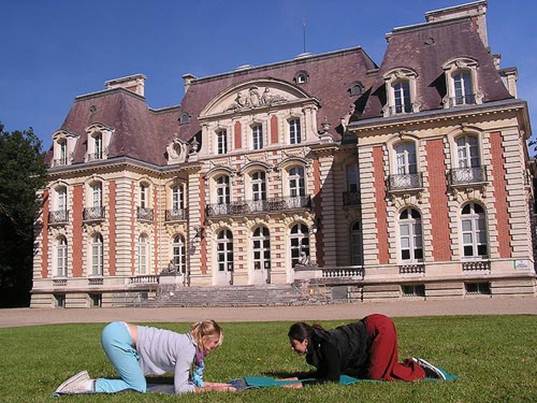Brazilian spirit
“I’ve been teaching for almost 30 years,
and I’ve collected stories form people who have really changed the way they
live just because of something I said in class or from practicing yoga. This is
very important to me”

Anderson allegro found his calling at a
young age. After reading about yoga in a book when he was 10 years old, Allegro
started entertaining his family by leading yoga classes in the living room, at
18, he found his first yoga teacher, and by the tender age 20, he began
teaching classes out of the garage at his family’s home. His studio is Sao
Paulo is now nearly two decades old, and it offers a variety of different
styles of yoga, teacher training programs, and sousing nights of kirtan
(devotional chanting) in the studio’s 3,000-quare-foot space.
On being a young, male, catholic yogi
“It was a revolution in my house because
may family was very Catholic, and they didn’t understand what was happening to
me. But yoga made me change my point of view and the way I was behaving. At
first, my family was a little worried; but after some time, they saw that ir
was good for me, and they agreed with my yoga practice. Now they all practice
yoga, and some of them work with me at my yoga school.”
On being spiritual, not religious
“Most of my students enjoy hearing about
the spiritual par of yoga. Once, a student came to me and said, ‘I don’t want
to do mantras because I’m Catholic.’ And I said, ‘That’s OK; you don’t need to.
No problem at all.’ So they know that we’re not pushing them into another
religion. They can decide what’s good for them.”
Last year, Allegro brought one of his gurus
from the Bihar School of Yoga in India to give a talk at his studio. He was
surprised by the enthusiastic participation of his students. “More than 100
people took initiation with her, which was a surprise for me. I was expecting
20 to 30 people, but 130 people! I think Brazilian people are becoming very
open to this spiritual part of yoga. This is what I want to teach more. It’s
not a religious approach, but we cannot deny this spiritual part of yoga.”

One having fun
Even though the practice is sacred and gear
to him, Allegro lightens things up from time to time with a wisecrack or a
practical joke. Last Christmas, he put a Santa Claus hat on the studio’s statue
of the elephant – headed Hindu deity, Ganesha.
French connection

“Sometimes I’ll sit in the entryway and
I’ll see people coming and going, and I’ll think, “Wow, I created this place.
And it’s such an important part of people’s lives.” It’s an important place for
them to express and distress and connect with the most profound things in their
lives. And it’s amazing to see.”
As a 16-year-old living in Frankfurt,
Germany, Daniela Schmid had never heard of yoga. But when a worldly cousin left
behind B.K.S. lyengar’s seminal book, Light on Yoga, Schmid was intrigued.
“That book became my little treasure,” says the owner of Rasa Yoga Rive Gauche.
She remembers pain-stakingly practicing along with it and being introduced to
the micromovements of the system – reading several paragraphs, then moving her
big toe, then reading some more, and rotating her thigh. After years of
studying yoga and working as an architect, Schmid opened her Paris studio in
2005. Sven years later, the studio is thriving, and Schimid is enjoying the
ride.
On diversity.
According to Schmid, yoga is still relatively
young in Paris. (She remembers getting phone calls from people just a few years
ago asking, “Are you a religious sect?”). Before she opened Rasa, there were
lyengar and Ashtanga Yoga studios in Paris, the few of them took an ecumenical
approach. Schmid offers more than 10 different styles of classes, form hatha
flow to lyengar to prenatal yoga, so that students of all ages and interests
can find something appealing, even as they change and evolve.

On beauty.
With her background in architecture, crafting
a beautiful, serene space was of paramount importance to Schmid. At Rasa, the
reception area is as big as the light-filled studio. She wanted the reception
space to provide students with an opportunity to chat, have tea, and connect
with each other as well as giving them an area to transition from the bustling
streets of the Left Bank to a calm, quiet space.
“At other studios, you had wonderful
teachers and classes. And you’d come out of this amazing class in complete
bliss, and you’d be thrown onto the street” says Schmid.”It was too abrupt”
On city living.
In a city where living space in small, the
Metro is crowded, and expectations for excellence abound, Schmid is thrilled to
see students go from being aggressive and rushed as they sign in for class to
being relaxed and centered as they leave.” I think, ‘Good, good. Take it with
you outside. Keep it there”
On giving back.
The practice of seva, or selfless service,
is important to Schmid. Through a partnership with a charity called Trees for
the Future, money from each purchase at the studio-whether it’s a class card, a
T-shirt, or juice-goes toward tree-planting projects. According to Schmid, Rasa
also supports 250 children in an orphanage in India who have opted to take yoga
twice weekly. “ They get their outfits and their mats, and they get to travel
to competitions and live for a few days outside of their world, “she says.” I
think it’s such a wonderful project. I just love it”.